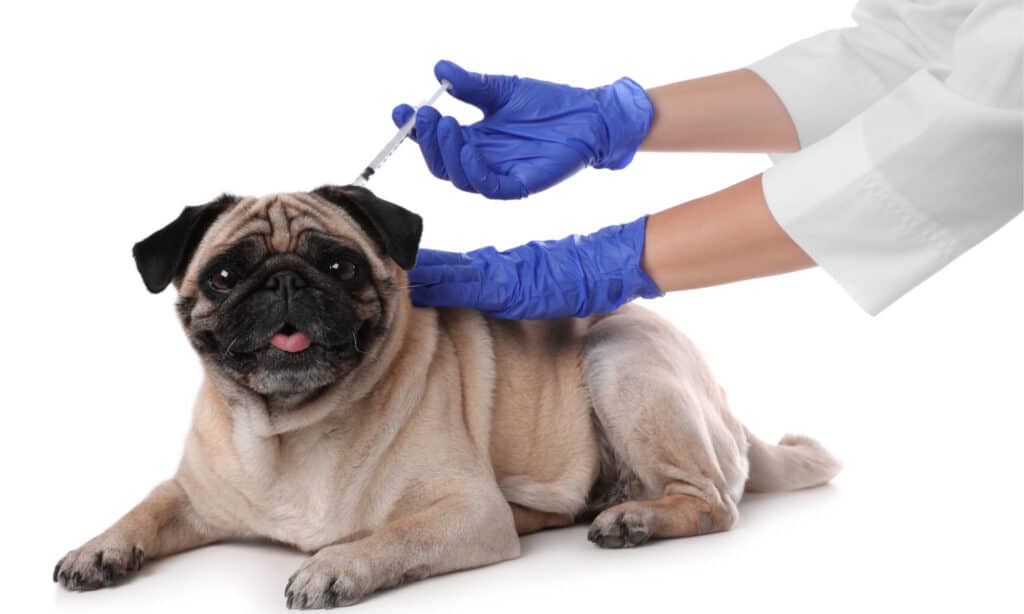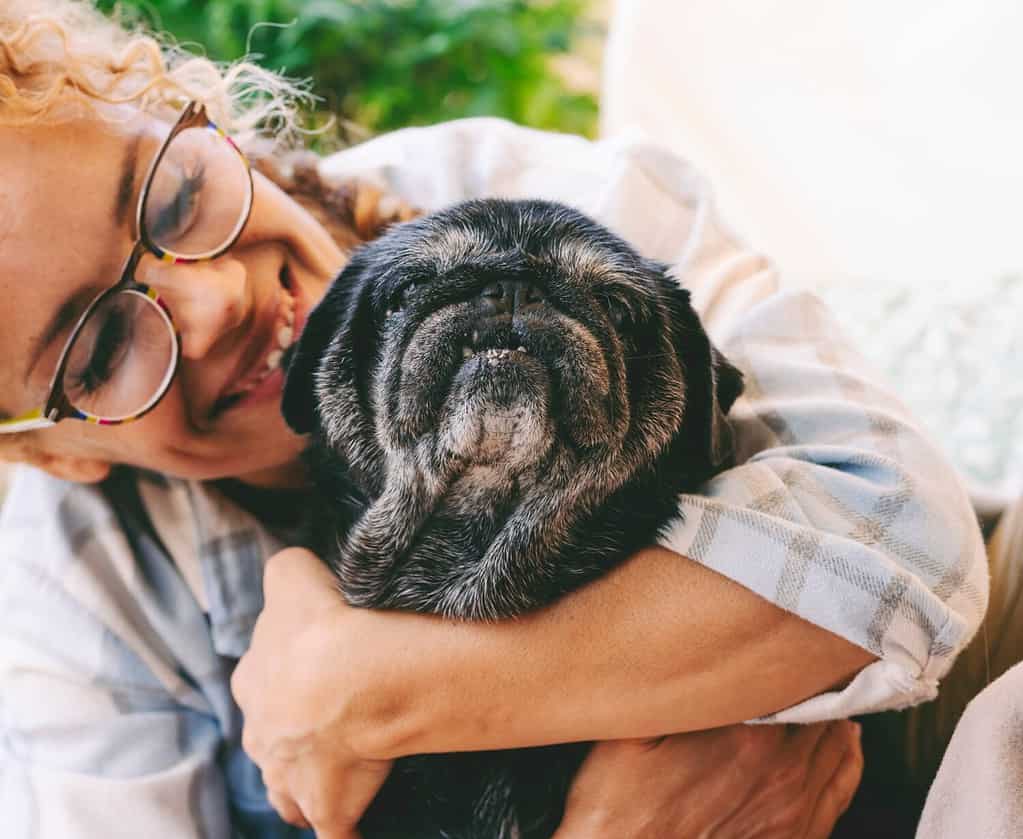Pugs are known for their playful temperament and sturdy physique. They’re family dogs, through. However, that doesn’t mean they’re right for every family. While some may find their characteristics endearing, others can find them annoying.
It mostly depends on what you’re looking for in a dog. A pug isn’t an athlete or very obedient, for instance.
Before adopting a Pug, it’s important to understand some of the reasons people don’t like them – just in case you would have the same complaints.
1. Health Issues

Vaccinations are important to protect your pug against what you can.
©iStock.com/Liudmila Chernetska
Pugs are notoriously unhealthy. There isn’t a way to get around this, even if you go with a quality breeder. Many of the pug’s “cute” characteristics directly cause health problems, such as their shortened snout and bigger eyes. There also isn’t a “good” side of these health problems. Yes, these dogs are cute, but you should be prepared for health issues.
The biggest problem is their shortened snout, which limits the amount of air they can breathe. They’re constantly on the verge of being out of breath, making them prone to exercise-induced exhaustion. They also can’t pant effectively, so they tend to develop heat-related conditions.
They’re also prone to eye diseases. They’re more likely to get their eyes injured, which is one reason many breeders don’t recommend them for homes with cats. Their eyes stick out just a bit too far to stay protected.
That said, you can avoid some of these issues by choosing dogs that have less dramatic traits. Choose pugs with longer snouts and smaller eyes.
2. The Sounds
Pugs tend to be rather noisy. But not in the usual, yappy way. Instead, they often make snuffling, wheezing, grunts, and snorts. Most pugs snore loudly. Some people don’t find this annoying and may even find the noises cute.
Others find these sounds incredibly annoying or may even stress about them
3. Stubbornness

Be cautious with overfeeding these dogs training treats, as they’re prone to obesity.
©NUKUL2533/iStock via Getty Images
Pugs are not made for training. They were made to be cute and cuddle. Some pugs are more obedient than others. They’re very people-centered, and your pug may listen to you just to make you happy. However, they will never be as obedient as a Labrador Retriever or similar breed.
Don’t expect them to win any obedience competitions. However, do train them still. Don’t skip training or set your expectations too low. Pugs should still be well-behaved.
Luckily, food is a great motivator for this breed. You can easily get them to behave by bribing them with treats. However, this can also make your pug overweight if you rely too heavily on treats. (Plus, you don’t want a dog that only listens to you when you have treats in your pocket.
4. Gassiness
Because these breeds have smaller snouts, they tend to suck in more air than other breeds. This excess air moves through their digestive system and makes them rather gassy. Some commercial diets can make this even worse, especially if fiber is high. You may need to try a few different foods to limit their gassiness as much as possible.
However, if the thought of a gassy dog drives you nuts, you probably shouldn’t purchase a pug, bulldog, or any other breed with a shortened face. It’s simply a part of living with these breeds.
5. Housebreaking

Pugs were bred to be companion animals, so they often work well in apartments.
©simona pilolla 2/Shutterstock.com
Sadly, pugs are pretty challenging to housebreak. Part of this comes from their lack of obedience and trainability. It takes them longer to pick up on this concept than other dogs, so you need to be extra patient. Plan on crate training them at the youngest age you can, as this can help with housebreaking substantially.
The other part of this difficulty comes from their smaller size. These canines are exceptionally small when they’re puppies, even though they gain weight quickly. Smaller puppies have smaller bladders and need to go outside more. Many owners may be unable to take them outside as much as they need to.
Therefore, for complete housebreaking, you often need to wait for them to grow a bit. You can start it when they are little, but plan on taking several months.
6. Shedding
Pugs shed all the time. Many people look at their shorter coats and don’t think they’ll shed much at all. After all, how could a short-haired dog shed much compared to a fluffy dog like a Pomeranian or Siberian husky? Well, evidently, a lot.
Pugs are easily one of the most high-shedding breeds around despite their very short coat. Of course, their shorter fur and size do mean that even when they shed heavily, they won’t make as much of a mess as a Malamute would. Still, it’s important to accept that your house will be covered in a layer of fur.
This breed also has two shedding seasons as the weather changes, usually sometime around the fall and spring. They will shed even more during this time, so we recommend investing in extra brushing sessions.
You should brush your pug a few times a week. Your main goal with this brushing session is to remove as much dust and dirt as you possibly can. It helps elongate the time between baths. Your secondary goal will be to remove fur. However, even with daily brushing sessions, your pug will still shed quite a bit.
7. Potential Separation Anxiety

We recommend taking these dogs with you when you can, as this helps provide extra socialization.
©sophiecat/Shutterstock.com
Pugs are very companion-oriented. Therefore, they can be prone to separation anxiety. If they aren’t taught how to be alone from a young age, they may be very bad at being alone. Separation may cause anxiety, leading to destructive behaviors like chewing and barking.
(Luckily, pugs are smaller, so the amount of damage they can do is low. They probably won’t chew through your wall like a husky would.)
You should crate-train your puppy to help prevent separation anxiety. Crate training gives your puppy plenty of time to be alone and teaches them that being alone is a good thing. If your dog is introduced to crate training gradually, they’ll be much less prone to separation anxiety later.
Dogs that are very anxious may need medication to help them cope with separation. However, you should always train your pug if they’re prone to separation anxiety. Medication should be a short-term fix while your dog is being trained – not a long-term solution.
8. Cost
Pugs from a good breeder cost a lot of money. These dogs have soared in popularity since around 2006, and their cost has increased with it. Some may be upwards of $2,000. Considering their lower lifespan and high frequency of health problems, this may be more than many potential dog owners are willing to pay.
While the pug itself can cost a lot of money, you also have to consider all the potential health problems. These bring inevitable vet bills, making the overall cost of the dog more. Plus, many brachycephalic breeds must pay extra fees at groomers and vets. Groomers can not leave them on the table as long due to their heightened chance of exhaustion.
9. Allergies

Be careful with portion sizes for Pugs, as they tend to eat far too much.
©Ezzolo/Shutterstock.com
Pugs are prone to allergies. There is likely a genetic reason for this, though it isn’t completely understood. While allergies are a health issue, they’re particularly hard to manage. Many dogs require medication if they are allergic to environmental factors like pollen. It’s simply too hard to keep them away from it.
However, if your pug is allergic to something in their food, you can attempt to switch them to a different food. Often, dogs are allergic to the proteins in their food, with chicken and beef being the most common. You’ll need to find a food that doesn’t contain your dog’s allergen.
Often, this is easier said than done. Many dogs are allergic to chicken, and practically every dog food contains chicken.
Pugs can become allergic to new things at any time. So, even if they’ve been eating he same food for years, they can become allergic to it. You may need to switch your dog’s food several times as they develop allergies.
The photo featured at the top of this post is © fongleon356/iStock via Getty Images
Ready to discover the top 10 cutest dog breeds in the entire world?
How about the fastest dogs, the largest dogs and those that are -- quite frankly -- just the kindest dogs on the planet? Each day, AZ Animals sends out lists just like this to our thousands of email subscribers. And the best part? It's FREE. Join today by entering your email below.
Thank you for reading! Have some feedback for us? Contact the AZ Animals editorial team.







